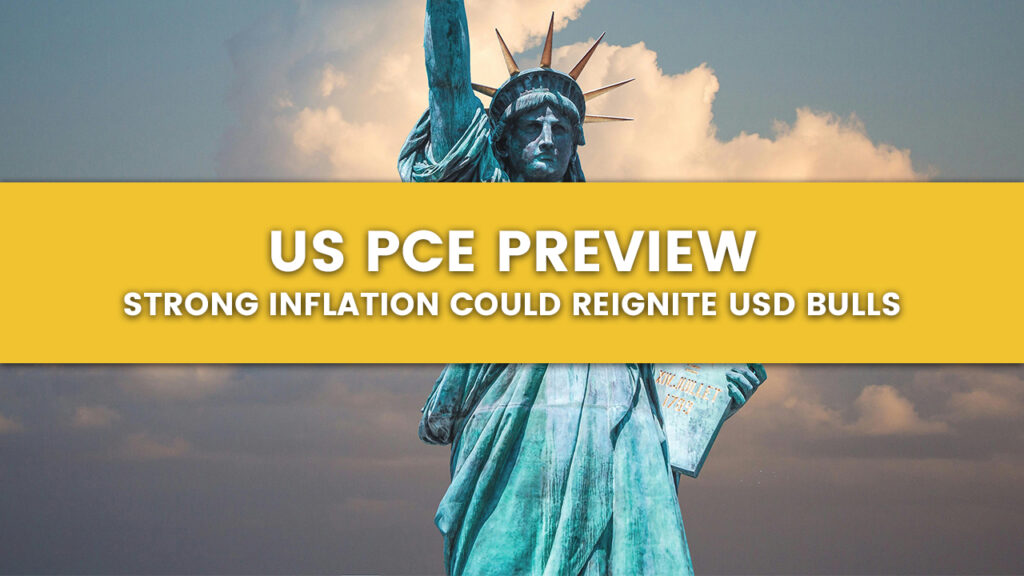US PCE Preview: Strong Inflation Could Reignite USD Bulls
Article published on January 29th, 2025 9:55AM UK Time

Markets are bracing for Friday’s release of the US Personal Consumption Expenditures (PCE) report, the Federal Reserve’s preferred inflation gauge. With recent consumer and producer price data painting a mixed picture, the focus will be on whether inflation remains on its disinflationary path or proves stickier than expected. A hotter-than-expected print could provide fresh momentum for USD bulls, challenging the market’s dovish Fed rate cut expectations.
Recent Inflation Data: A Mixed Signal
December’s inflation readings showed headline CPI rising 0.4% M/M, above the expected 0.3% (unrounded: 0.393%), while core CPI moderated to 0.2% M/M, in line with expectations (unrounded: 0.225%). Producer prices, however, came in softer, with PPI rising 0.2% M/M, below expectations of 0.3%, and core PPI remaining unchanged, undershooting the 0.3% forecast.
In response, Morgan Stanley estimated December’s headline PCE at 0.26% M/M and core PCE at 0.16% M/M, reinforcing expectations that inflation is cooling. However, the dispersion in inflation signals has left investors cautious about how Friday’s data might shape the Fed’s next steps.
Fed’s Position: A House Divided
Prior to tonight’s Fed meeting has seen Federal Reserve officials remain split on the inflation outlook. Fed Governor Waller recently expressed optimism, believing inflation will continue easing towards the 2% target, while Fed’s Goolsbee pointed out that PCE inflation has been running close to the Fed’s target over the last six months. This aligns with market pricing, which currently anticipates the first 25bps rate cut in March, followed by another in June.
However, not all policymakers are convinced that the inflation fight is over. Fed Governor Bowman has warned of upside risks, arguing that progress on inflation may have stalled. The December FOMC minutes further revealed that “some” members saw merit in keeping rates unchanged for longer, citing risks of persistently high inflation. Trump’s tariffs could offer inflation forces that can’t be ignored until the US administration’s policy becomes clearer.
Market Expectations and USD Impact
Morgan Stanley expects core PCE inflation to slow from 2.8% Y/Y in 2023 to 2.5% Y/Y in 2024, with a further decline to 2.4% Y/Y in 2026. However, should the PCE print come in hotter than expected, markets may be forced to reconsider the Fed’s rate cut trajectory, leading to a repricing of expectations and renewed strength in the US dollar.
A stronger-than-expected PCE print would reinforce concerns that inflation is proving stickier than Fed doves anticipate. This scenario could prompt a hawkish recalibration in rate expectations, driving US yields higher and supporting USD appreciation, especially against currencies where central banks are actively considering cuts.
Conversely, a weaker PCE reading would validate market expectations for a March rate cut, potentially weighing on the dollar and reinforcing risk appetite across asset classes.
Key Levels to Watch
- A core PCE print above 0.2% M/M or above 2.6% Y/Y could shift market pricing towards fewer rate cuts in 2024, providing fuel for USD bulls.
- A downside surprise—0.1% M/M or lower—would embolden the dovish case, pressuring the dollar while lifting risk assets.
Bottom Line
With the Fed at a critical juncture, Friday’s PCE print could prove pivotal. If inflation proves sticky, the USD could regain its bullish momentum. However, a softer reading would reinforce the current disinflation narrative, opening the door for policy easing sooner rather than later. There is likely to be a two way opportunity on this print with an out of consensus print to the upside or the downside.